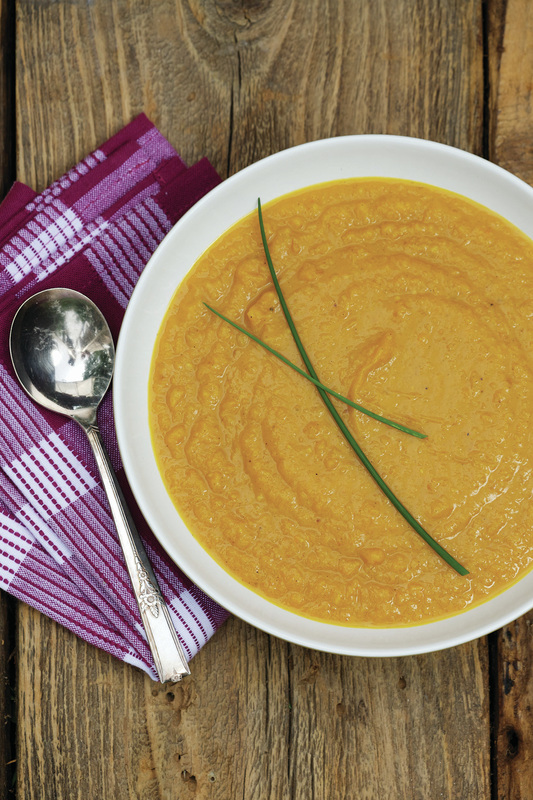|
Spiced Ambercup Squash Soup with Maple Syrup
Excerpted from Homegrown, by Mairlyn Smith. Reprinted with permission of Whitecap Books, 2015. By Jennifer Goodwin, P.H.Ec. This deep orange coloured soup has the best of both flavour-note worlds; it’s a little bit spicy and a little bit sweet. It was a huge hit the day we tested it, and the flavours are well worth the work it takes to hack open the squash. INGREDIENTS One 3 lb (1.4 kg) ambercup squash (see note) 3 Tbsp (45 mL) canola oil, divided 1 large onion, chopped 3 cloves garlic, minced 3 cups (750 mL) no salt added vegetable broth 1 Empire apple, peeled, cored and chopped 1 tsp (5 mL) grated fresh ginger (see note) 1 tsp (5 mL) Madras curry powder 1/2 tsp (2 mL) cinnamon 1/4 tsp (1 mL) nutmeg, freshly grated 1/2 tsp (2 mL) iodized salt 1/4 tsp (1 mL) freshly ground black pepper 1–2 Tbsp (15–30 mL) amber or dark pure maple syrup 2 cups (500 mL) skim milk 1/8–1/4 tsp (0.5–1 mL) green Tabasco sauce 16 chives, for garnish (optional) METHOD 1. Preheat oven to 375°F (190°C). With a large sturdy knife, cut the squash in half and remove seeds and pulp. Peel and dice into 1-inch (2.5 cm) chunks; place into a large roasting pan. Drizzle with 1 1/2 Tbsp (22 mL) oil and toss to coat. Roast for 45 minutes or until the squash is soft and beginning to brown slightly. Toss occasionally throughout the roasting process to prevent burning. 2. When the squash is cooked, heat a large saucepan over medium heat. Add the rest of the oil plus the onion and garlic, sauteing until soft and slightly browned, about 5 to 7 minutes. Remove from heat and add the squash. 3. Place the empty roasting pan on a separate element over medium heat and pour in broth. Once the liquid begins to boil, reduce to simmer, scrapping up any bits for added flavour. Pour into the large saucepan. 4. Add apple, ginger, curry, cinnamon, nutmeg, salt and pepper. Return to heat and bring to a gentle boil; reduce heat, cover and simmer until the apple is soft, about 15 minutes. 5. Add maple syrup, milk and Tabasco and stir in well. Remove from heat. Using a hand held immersion blender, puree the soup OR transfer to a blender or food processor and puree in smaller batches and return soup to saucepan. Garnish with whole chives if desired. See picture. 6. Reheat if necessary; serve or store in the fridge for up to two days. Freeze any leftovers up to three months. Makes 8 cups (2 L) One serving = 1 cup (250 mL) Per serving: 176 Calories, 5.7 g Total Fat, 0.5 g Saturated Fat, 0 g Trans Fat, 202 mg Sodium, 31 g Carbohydrate, 4 g Fibre, 13 g Sugars, 1.5 g Added Sugars, 4.3 g Protein Carbohydrate Choices: 2 Madras Curry Powder In traditional South Asian cuisine, a curry is a dish cooked in a sauce. To most Canadians however, a curry is a powder that you add to a dish to give it heat. Curry powders are created by blending many spices together, and blends of curry powders range from spicy to very spicy, depending on what area that curry blend was created. Sweating cools you down, so areas that are very hot tend to have curry blends that produce sweating. Madras is an area in India that is very hot, hence this blend is fairly spicy. Ingredient Note: Ambercup Squash-- Ambercup squash is a deep orange squash that looks like its cousin the buttercup squash. Its flesh is darker in colour and slightly sweeter in flavour. Can’t find an Ambercup? Buttercup (or their more distant cousin Butternut) will also work for this recipe. Ginger—Peel ginger using the bowl of a spoon, holding the stalk of the spoon and then dragging it down the sides of the ginger; wrap and store any leftover ginger in the freezer. Grate into recipes as needed. PHEc Tip: This soup may be quite thick depending on the type and age of the squash. Add more broth, water or milk until you reach desired thickness.
0 Comments
Your comment will be posted after it is approved.
Leave a Reply. |
The Ontario Home Economics Association, a self-regulating body of professional Home Economists, promotes high professional standards among its members so that they may assist families and individuals to achieve and maintain a desirable quality of life. Categories
All
Archives
April 2024
|
|
Subscribe to our mailing list
|
|
Unsubscribe from our mailing list
|
Copyright © 2023 Ontario Home Economics Association (OHEA). All Rights Reserved.



 RSS Feed
RSS Feed